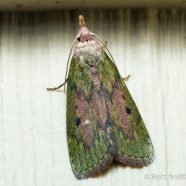Asters
Some of our latest blooming flowers are the asters, and they are essential for the bees, butterflies and other insects still flying in October and November. Please make sure your yard has nectar and pollen sources from when the snow melts in spring until the first flurries fall in autumn.
Read MoreBumblebee & Beetle
One of the many, many bumblebees in my yard looked just off. When I caught it for a closer look, it had a hitchhiking beetle attached to one of its antenna! These flower beetles (Antherophaga sp.) feed on flowers as adults, but their larvae feed on detritus inside bumblebee nests. Apparently, the easiest way to get from one place to the other is to latch onto a passing bumblebee and go along for the ride! Who knew? Photographed for the Meet Your Neighbours global biodiversity project and the Roger Tory Peterson Institute of Natural History. Twan Leenders RTPI President
Read MoreMilkweed Bee
The bees love the milkweed! Whether it is bumble, honey, metallic or otherwise, these buzzy pollinators have been all over the Swamp Milkweed (Asclepias incarnata) lately. There are finally a lot more butterflies out and about, nectaring frequently on delicious, chemical-free and native pollinator plants. I will show you more of what we have all seen lately all month long. Scott Kruitbosch Conservation & Outreach Coordinator
Read MoreThe Bee Moth
This pretty moth gave me a tough time trying to pin down an identification, but it looks to be a female Aphomia sociella – The Bee Moth. I was less enthusiastic in learning that Aphomia sociella is a non-native and often pest moth that was likely introduced from Europe via the colonists and bee hives. They often end up destroying those hives from the inside out. Everything has its place, I suppose… Scott Kruitbosch Conservation & Outreach Coordinator
Read More








